TRASTEVERE ALONG THE CENTURIES
Trastevere is the XIII district (=rione), of Rome, while in Augustan era it was the XIV regio (regio = rione). It retains the name of the ancient Augustan regio, when was called Trans Tiberim (=beyond the Tiber), to distinguish it from other regiones, who were on the left bank of the river.
The district for centuries has preserved its markedly popular identity, with artisans and taverns.
Few traces of ancient Rome are visible: at Lungara street the Settimiana gate, named in honor of the emperor Septimius Severus (146 - 211), or his son Septimius Geta (189 – 211), brother of emperor Caracalla. Later. Under Nicholas V, the humanist Pope Lungara street that connected Settimiana gate with Santo Spirito (=Holy Spirit), gate and then brought to the Vatican, was called Holy street.
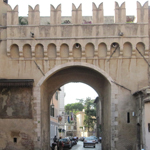 |
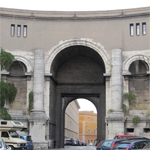 |
Settimiana gate - click to enlarge |
Santo Spirito gate - click to enlarge |
Going back to ancient Rome, near the Gardens of Caesar, which he bequeathed to the Roman people, close to the present Ministry of Education, in 1889 it was discovered a sanctuary devoted to Hercules, and in excellent conditions the portraits of seven charioteers.
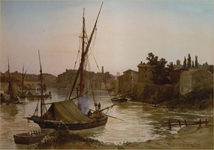 |
Ripa Grande harbour - click to enlarge |
Moreover the ancient Trastevere in the imperial era, given the proximity to the Ripa Grande harbour, was one of the most densely populated, especially by artisans.
The cults that were practiced, as appears from inscriptions found, prove that in the district had installed large colonies of Syrians and Jews.
Besides, the oldest Jewish cemetery in Rome was discovered near Portese gate, that is in Trastevere.
Today continues the fascinating maze of narrow medieval streets, surrounding famous churches and famous palaces, according to that typical characteristic of Rome and Trastevere too, whereby the humblest of the common people lived in close contact with the noblest of the nobles.
GLANCING AT TRASTEVERE
For convenience of visitors of Trastevere recommend across the Tiber passing the Ponte Sisto (built by Sixtus IV della Rovere, for the Jubilee of 1475), you face the fountain of Paul V Borghese (1552 to 1621), which according to the inscription is connected with the above Acqua Paola “Fontanone” (=great fountain), who actually insists on the old Trajan “Aqua”.
Click to enlarge pictures |
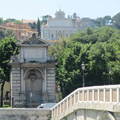 |
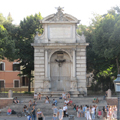 |
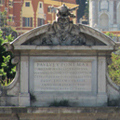 |
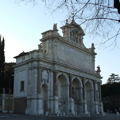 |
Ponte Sisto |
Fountain of
Paolo V Borghese |
The inscription on the fountain
of Paolo V Borghese |
Acqua Paola “Fontanone” |
Taking the road that hugs to the right the fountain you get to Settimiana Gate, passing by the church of St. Sylvester and St. Dorothy.
Going along Via della Lungara, a hundred yards or so, on the right is the current entrance to the Villa Farnesina.
You can’t say to have been to Rome if you have not seen the Villa with frescoes by Raphael, Sebastiano del Piombo, Baldassarre Peruzzi and Sodoma.
The Villa, which is now the official seat of the Accademia dei Lincei, can be visited every weekday from 9 a.m. to 2 p.m.
Here we suggest a detailed visit (click an’ see), always remembering that our visits are meant as a guide for your visits in the presence, in fact, nothing can replace the direct and unmediated relationship between the visitor and the masterpieces.
Almost opposite the Villa Farnesina stands the Palazzo Corsini with all the masterpieces of his gallery by: Caravaggio, Beato Angelico, Filippo Lippi, Andrea del Sarto, Salvator Rosa, Guido Reni, Giovanni Lanfranco, Murillo, Josè de Ribera, Paolo Rubens, Canaletto, Luca Giordano, Baciccia and others.
Along Via Corsini, faith in one hundred yards or so, we arrive at the entrance of the Botanical Garden which we offer a preview.
The Garden is open every weekday from 9 a. m. to 18.30 p.m.
Return to Settimiana gate, which, as we say, probably is so called because Septimius Geta son of Septimius Severus in this area had its Horti (=gardens).
Click to enlarge pictures |
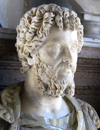 |
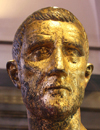 |
Septimius Severus |
Aureliano |
Moreover the door itself was built about 60 years after the death of Geta, by Emperor Aureliano around 270, when in addiction of the walls erected on the left of the Tiber, he built an additional wall to protect Trastevere, that wall from Settimiana gate went up the Janiculum, to reach the current San Pancrazio gate, finally descending to the Portuensis gate, next to the current Porta (=gate) Portese. Some of these walls have been incorporated into the Mura (=walls) Gianicolensi erected by Pope Urban VIII in 1643, the rest was shot down and instead of the Portuensis gate was built Porta Portese.
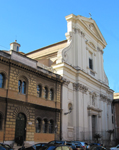 |
|
Santa Maria della Scala
click to enlarge |
Returning to Settimiana gate, its present appearance is due to Pope Alexander VI Borgia (1493), and this explains the Guelf merlons you see on its summit.
After passing through the gate, almost opposite path of via della Lungara, we find via della Scala, which leads to piazza della Scala where stands the church of Santa Maria della Scala, which you can see a preview here.
Wandering around the Piazza and Via della Scala, passing through Via della Paglia, Piazza Sant’Egidio, Vicolo del Cedro, Vicolo del Leopardo, Vicolo dei Panieri, Via del Mattonato, you can enjoy those glimpses which suggest the true atmosphere of Trastevere.
At Piazza Sant'Egidio is the Museo di Roma in Trastevere, which, among other things exposes fourty watercolors of Rome vanished, paintings by Ettore Roesler Franz (1845 - 1907), that in spite of the name was Roman, and according to many connoisseurs is the most important Italian watercolorist of all time.
To get from Piazza Santa Maria della Scala into Piazza Santa Maria in Trastevere we walk, guess what: one hundred yards or so.
The Square is the heart of Trastevere and the Basilica is one of the jewels, not only of Trastevere, but of Rome too and then of Italy, therefore of the world (deductive processes work like that).
Here you can have a detailed visit, click and see.
Regarding the visit to the church, the churches, let us give you a few tips: if you can avoid a visit on Sunday, because it is most inappropriate to visit a church during Mass, and secondly if you have binoculars, be sure to take it.
From Piazza Santa Maria in Trastevere, one hundred yards or so, taking the Via della Lungaretta arrive at the Basilica of San Grisogono, which opens on Viale Trastevere.
Surprise! hundred yards, or less and turning left you reach Piazza Belli, where you can see the statue of the great poet Gioachino Belli.
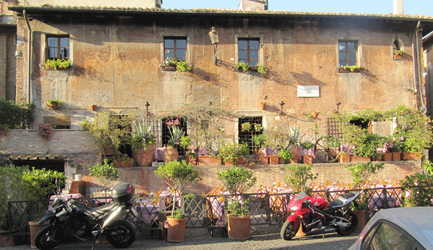 |
Piazza de’ Mercanti - click to enlarge |
Returning to Via the Lungaretta, sliced from Viale Trastevere, from here to Piazza in Piscinula and then to Piazza de 'Mercanti, we can see other characteristic glimpses of Trastevere, as Vicolo della Luce, Via dell’Arco dè Tolmei, Vicolo dei Tabacchi, Via del Porto (=Harbour), so called because close to Harbour of Ripa Grande, the largest of Rome, which came, up the Tiber, the great ships from the Port of Trajan at Ostia Antica.
To get an idea of the size of the harbour of Ripa Grande, just look at the Monte dei Cocci (=hill of the shards), it rises on the opposite bank of the Tiber, where stood the old warehouses (=Horrea) of the harbour, well, the Monte dei Cocci was the dumping of stores and shards are the remnants of amphorae used as containers, arranged in layers. The shards were called testae, here is the name assigned to the Testaccio district that was built around the Horrea.
Piazza dè Mercanti is adjacent to Piazza di Santa Cecilia, where is the unforgettable Basilica of Santa Cecilia, with the impressive statue of St. Cecilia the top masterpiece of Stefano Maderno, the extraordinary ciborium by Arnolfo di Cambio and in the apse the famous mosaic of the IX century.
If you want to see, in Santa Cecilia convent, the Last Judgement by Pietro Cavallini, one of the greatest masterpieces of medieval art, it is good to know that the visits are possible every working day from 10 a.m. to 12.30 a.m.
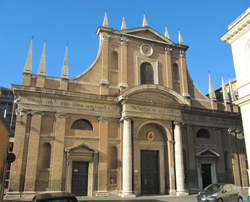 |
Santa Maria dell’Orto - click to enlarge |
From Piazza di Santa Cecilia, taking on St. Michael street, on which stands the imposing structure of the Ancient Apostolic Hospice of San Michele, and then Santa Maria dell’Orto street, let's say 150 yards or so, we come to church Santa Maria dell’Orto, which we present a preview.
The area around the church, for closeness to the harbour of Ripa Grande, until 1800 was the center of commerce for the provisioning of Rome.
The shopkeepers in the area, becoming members of the Venerable Confraternity of Santa Maria dell’Orto, founded the church of the same name, which they still care.
The Confraternity was established by universities, to avoid misunderstandings it is good to know that were called universities the guilds and in fact the Ortolani (=greengrocers) and Pizzicaroli (=delicatessen shopkeepers) were the founding members.
Left Santa Maria dell’Orto, going right along Via Anicia, a hundred yards or so, here we are at the Church of San Francesco a Ripa, with the famous Beata Albertoni by Bernini and other masterpieces.
Dear friends of one hundred yards in a hundred yards or so, we walked for a few kilometers or so.
Let us rest.
If instead of entering into Trastevere, across the Ponte (=bridge) Sisto, you want to proceed in the opposite direction, can pass through the Tiber Island across Ponte Fabricio and Ponte Cestio, running a few steps from Piazza Piscinula.
Good trip!
back |

